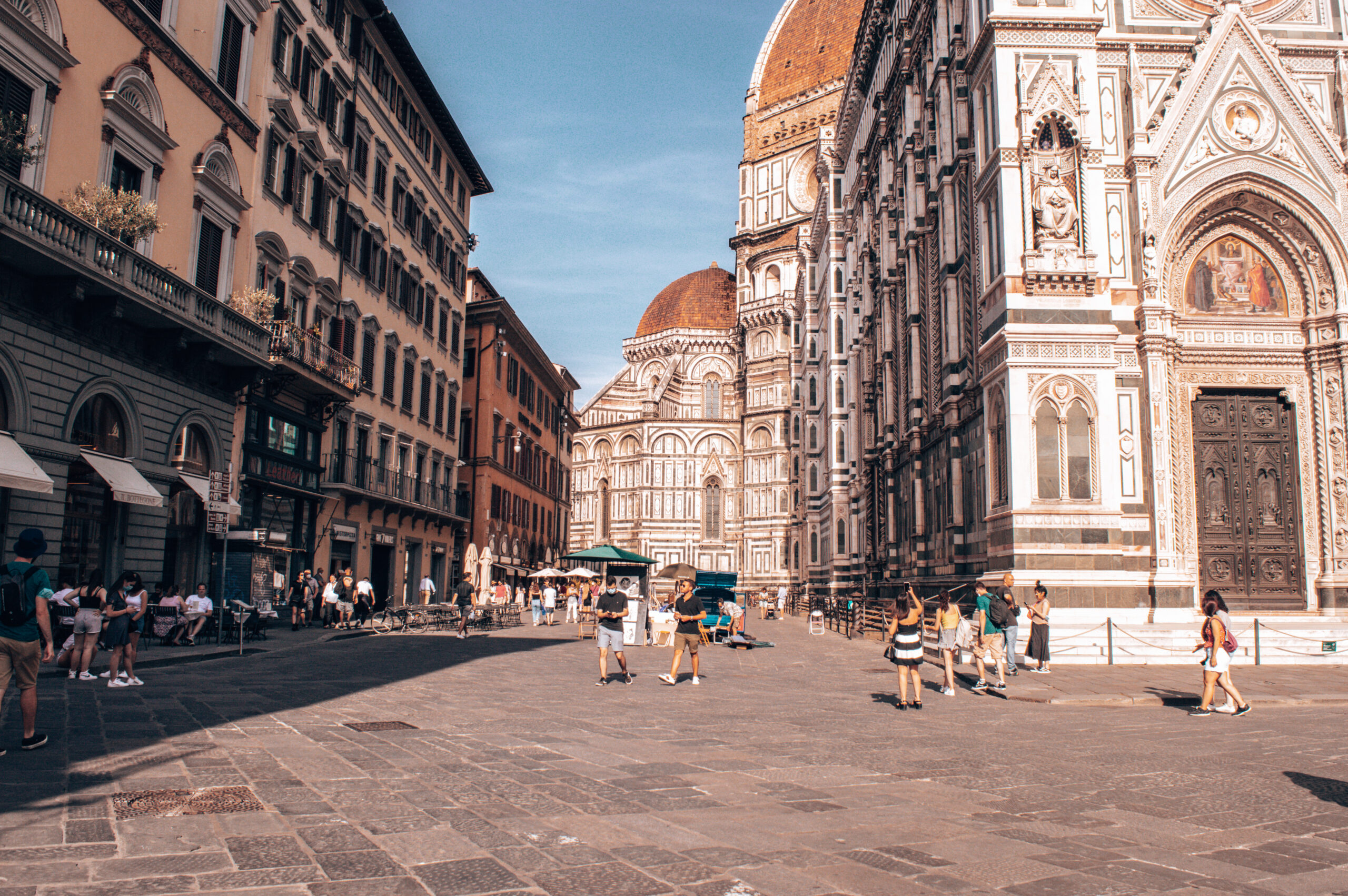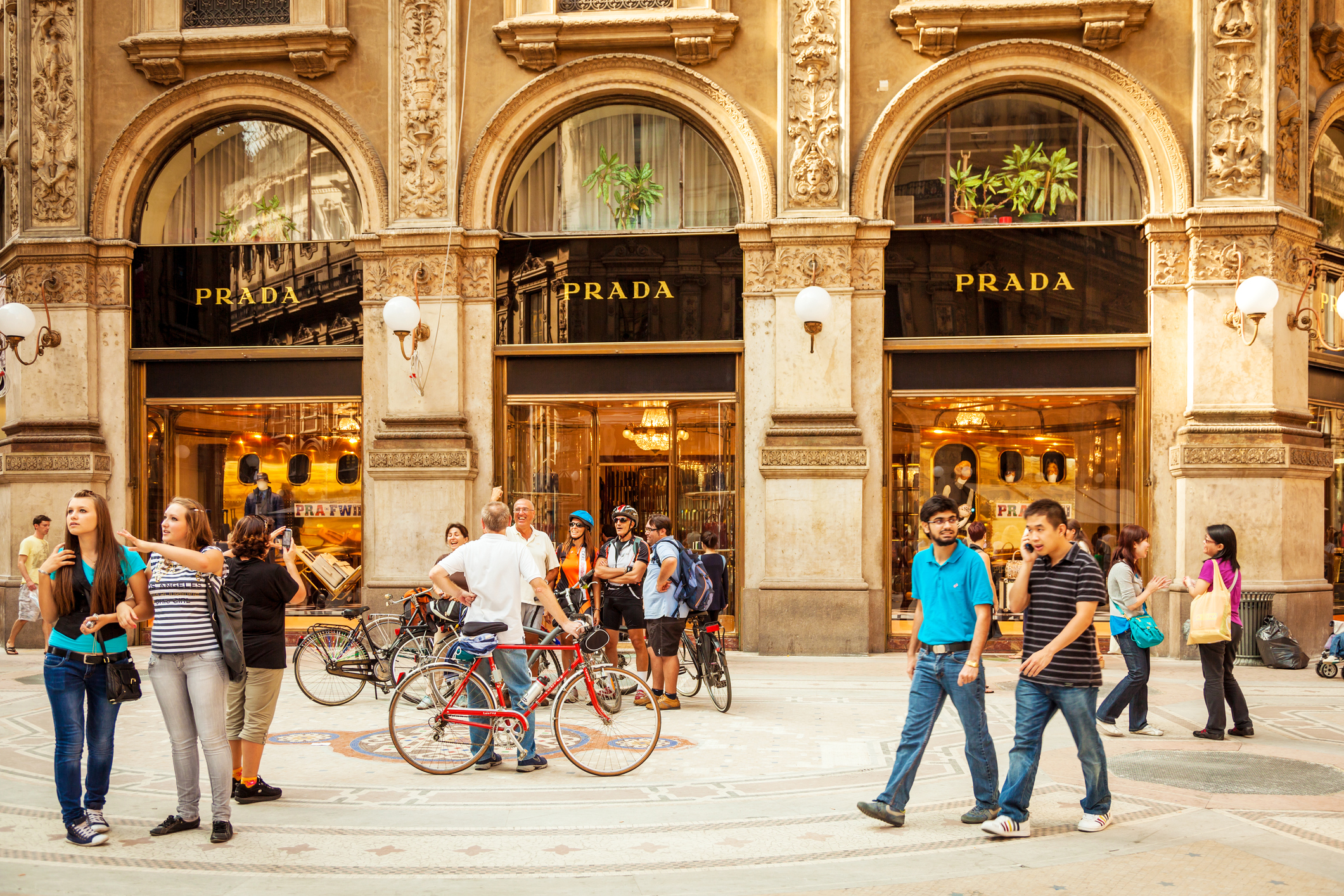Economy, Costs & Transport
Economy and the Biggest Industries in Italy
Italy has a developed economy with several significant industries contributing to its GDP. It is diverse, with strengths in manufacturing, services, and tourism. Some of the biggest industries in Italy included:
Manufacturing

Italy is renowned for its manufacturing sector, particularly in automotive, machinery, fashion and textiles, and design. Globally recognized companies include Fiat Chrysler Automobiles, Ferrari, and Prada
Tourism

Italy is a major tourist destination, attracting millions of yearly visitors to its historic cities, art and cultural treasures, beautiful landscapes, and coastline. Tourism plays a crucial role in the Italian economy.
Fashion and Design

Food and Beverage

The agri-food sector is vital to the Italian economy. Italy is known for its high-quality food and wine; exports of products like pasta, olive oil, wine, and cheese contribute significantly to the economy.
Finance and Banking

Italy has a well-developed financial sector, with Milan serving as the country’s financial hub. The banking and finance industry is essential to Italy’s economic infrastructure.
Automotive Industry

Italy has a strong presence in the automotive industry. In addition to manufacturing cars for domestic use, Italian automotive companies export vehicles globally. Fiat, now part of Stellantis, is a significant player.
Chemicals and Pharmaceuticals

Italy has a robust chemicals and pharmaceutical industry. Companies like Luxottica (eyewear), Eni (energy, chemicals), and pharmaceutical companies contribute significantly to this sector.
Renewable Energy

With a growing focus on sustainability, Italy has invested in renewable energy sources, such as solar and wind power. The country aims to increase its share of renewable energy in the overall energy mix.
Parexstudy
Housing in Italy
1. Renting in Italy
2. Types of Rental Properties
- Apartments (Appartamenti): Common in urban areas, apartments vary in size and amenities.
- Houses (Case): You may find standalone houses in suburban or rural areas.
- Rooms (Camere): Renting a room in a shared apartment is a cost-effective option.
- Short-Term Rentals: Vacation rentals are popular in tourist destinations.
3. Rental Costs
- Rent: Prices vary significantly depending on location, size, and amenities.
- Utilities: Some rentals may include utilities, while others require separate payments.
- Condominium Fees (Spese Condominiali): These fees cover communal expenses in apartment buildings, such as the cost of a security guard and corridor and elevator cleaning.
4. Rental Contracts
- Types of Contracts: There are different types of rental contracts, such as “Contratto a Canone Concordato” (the rent is determined and regulated by the government) and “Contratto a Libero Mercato” (free-market lease).
- Lease Duration: Rental contracts typically last four years, renewable for another four years. Shorter contracts may be available for temporary stays.
- Deposit (Caparra): It’s common to pay a security deposit, usually equivalent to a few months’ rent.
5. Finding a Rental
- Real Estate Agencies: Many rentals are listed through real estate agencies. They can help you search for a house and arrange documents. The commission of the real estate agency may vary, but usually, it is equal to 15% of the total rent for one year.
- Online Platforms: Websites like Immobiliare.it, idealista.it, and Airbnb are commonly used for property searches.
- Local Newspapers: Some property listings may be found in local newspapers.
6. Required Documents
- Codice Fiscale: An Italian tax code you’ll need for various transactions, including renting.
- Reference Letters: Some landlords may ask for references from previous landlords or employers.
- Identification: A copy of your passport or other identification.
7. Legal Considerations
- Rental Agreements: It’s essential to have a written rental agreement specifying the terms, conditions, and responsibilities of both parties.
- Registration: The lease should be registered with the local tax office.
- Tenant Rights: Tenants in Italy have specific rights, and landlords must follow legal procedures for eviction.
8. Tips
- Negotiation: Rent prices may be negotiable, especially for longer leases.
- Visit the Property: Always visit the property before committing to a lease.
- Language: While many people in urban areas speak English, it can be beneficial to know some basic Italian, especially when dealing with local landlords or agencies.
- Legal Assistance: If you’re unfamiliar with Italian rental laws, consider seeking legal advice before signing any agreements.
Cost of Living in Italy:
1) Accommodation:
Rent: In major cities (1-bedroom apartment): €800 – €1,500 per month
In smaller towns or rural areas: €500 – €1,000 per month
Utilities: Essential utilities for a standard apartment: €100 – €200 per month
2) Food:
Monthly grocery cost for one person: €200 – €300
Meal at an inexpensive restaurant: €10 – €20
Three-course meal for two at a mid-range restaurant: €50 – €80
3) Transportation:
Monthly public transportation pass: €30 – €70 (varies by city)
1 liter of gasoline: €1.60 – €1.80 (changes often)
4) Healthcare:
Private health insurance for one person: €50 – €100 per month
State insurance for students: 150 euros for one year
5) Miscellaneous:
Internet (60 Mbps or more, unlimited data): €25 – €40 per month
Mobile phone plan: €10 – €20 per month
Clothing and Personal Items: Vary based on personal choices
6) Leisure & Entertainment:
- Museum entrance fee: €8 – €15
- Theater ticket: €20 – €50
- Gym membership: €30 – €60 per month
7) Additional Tips:
- Local vs. Tourist Areas: Prices may be higher in tourist areas.
- Cook at Home: Cooking at home using local ingredients can save money.
- Public Transportation: Choose public transportation to eliminate the parking fee.
- Explore Local Markets: Local markets offer fresh and affordable produce.
- Budgeting: Creating a budget based on personal circumstances is crucial
Salaries in Italy:
Information Technology:
Junior IT professional: €25,000 – €40,000 per year
Senior IT professional: €40,000 – €70,000 per year
Finance:
Junior finance position: €30,000 – €45,000 per year
Senior finance position (e.g., financial manager): €50,000 – €100,000+ per year
Engineering:
Entry-level engineer: €28,000 – €40,000 per year
Experienced engineer: €40,000 – €70,000+ per year
Healthcare:
Registered Nurse: €25,000 – €40,000 per year
Medical Doctor: €50,000 – €100,000+ per year
Education:
Teacher (primary or secondary education): €25,000 – €40,000 per year
Marketing and Sales:
Junior marketing/sales: €25,000 – €40,000 per year
Senior marketing/sales manager: €40,000 – €80,000+ per year
Location-Based Variations:
Salaries vary significantly between regions, with cities like Milan and Rome generally offering higher wages than smaller towns or rural areas.
Additional Considerations:
- Benefits and Bonuses: Benefits such as healthcare, retirement contributions, and bonuses can significantly impact the compensation package.
- Contract Type: Permanent contracts typically come with more benefits, while temporary or freelance positions might offer higher hourly rates but fewer benefits.
- Experience and Education: Higher education and more years of experience generally lead to higher salaries.
- Negotiation: Salary negotiations are typical in Italy. It’s acceptable to discuss compensation during the hiring process.
- Cost of Living: Consider the cost of living in the specific region when evaluating salary offers.
Stay Informed: Research the areas you plan to visit and stay informed about local news and events. Be aware of any travel advisories or warnings issued by your government.
Secure Your Belongings: Keep your belongings secure, especially in crowded places like markets and tourist attractions. Use a money belt or neck pouch to carry important documents, cash, and cards.
Watch Out for Pickpockets: Be cautious in crowded areas and public transportation, where pickpockets may operate. Keep an eye on your belongings, especially in busy tourist spots.
Use Reputable Accommodations: Choose well-reviewed hotels or accommodations, especially in unfamiliar areas. Use reputable booking platforms to ensure the legitimacy of your reservation.
Be Cautious with Personal Information: Be cautious about sharing personal information, especially with strangers. Avoid discussing travel plans with people you don’t know well.
Stay Hydrated and Sun-Protected: Italy can be hot, especially in the summer. Stay hydrated and use sunscreen to protect yourself from the sun.
Learn Basic Italian Phrases: While many Italians speak English, especially in tourist areas, learning some basic Italian phrases can be helpful and appreciated.
Transport in Italy:
1) Public Transportation:
- Trains: Italy has an extensive and efficient railway network connecting major cities and towns High-speed trains, such as the Frecciarossa, Frecciargento, and Frecciabianca, offer quick connections between cities. Regional trains serve more diminutive towns and rural areas.
- Buses and Coaches: Buses and coaches complement the train network, providing transportation to areas not covered by trains. Local buses operate within cities and towns.
- Subways and Trams: Major cities like Rome, Milan, and Naples have subway systems, making it convenient to navigate urban areas. Trams are also available in some cities.
- Ferries: Ferry services connect coastal regions and islands.
2) Road Transportation:
- Cars and Motorcycles: Italy has a well-maintained road network, and renting a car is a popular option for exploring the countryside. Cities have well-developed road systems, but traffic congestion can be an issue, especially in larger urban centers. Motorcycles and scooters are standard in towns and are often used for commuting.
- Highways: Italy has a network of toll highways (autostrada) connecting major cities.
3) Air Travel:
- Airports: Italy has several international airports, with major airports in Rome, Milan, Venice, and other cities. Domestic flights are available for those looking to travel quickly between regions.
4) Taxi Services:
Taxis are available in cities and can be hailed on the street or booked in advance.
5) Biking and Walking:
Many Italian cities are pedestrian-friendly, and walking is a popular mode of transportation for short distances. Bike-sharing programs are available in some cities.
Tips and Considerations:
Integrated Ticketing: Some cities offer integrated ticketing systems that allow passengers to use multiple forms of public transportation with a single ticket.
Taxis and Ride-Sharing: Taxis are widely available in urban areas, and ride-sharing services like Uber operate in certain cities.
Driving in Italy: If you plan to drive, be aware of traffic rules, ZTL (limited traffic zones) in specific city centers, and parking regulations.
Regional Differences: Transportation options and efficiency can vary by region, with major cities having more comprehensive services.
Rail Passes: For tourists, rail passes can offer cost-effective and flexible travel options.
